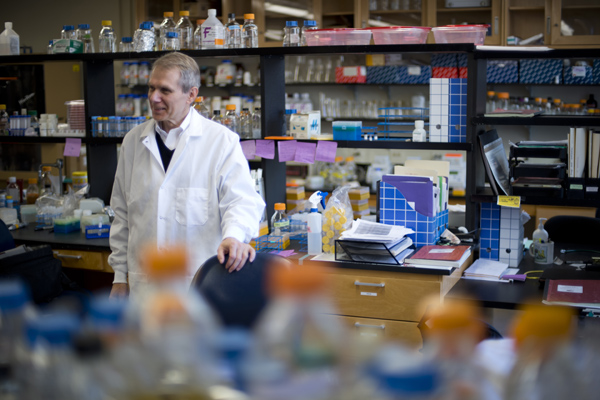3Qs: A new path to curing chronic Lyme disease

Earlier this year, the Centers for Disease Control and Prevention projected the number of undiagnosed cases of Lyme disease to be 10-fold higher than previously believed. Of the newly identified 300,000 people infected each year, between 30,000 and 60,000 fall into the category of having chronic Lyme, where symptoms persist despite zero evidence that the pathogen remains in their bodies. With the support of a Lyme Research Alliance grant, University Distinguished Professor of Biology Kim Lewis in the College of Science is exploring alternative approaches to curing chronic Lyme disease. We asked him to explain his research goals and why now is the perfect time to find a cure.
Why is Lyme a difficult disease to identify and treat?
Lyme is one of those puzzling chronic diseases: while people that are treated by antibiotics shortly after they’re bitten by the tic get cured, about 10 to 20 percent don’t. So, the question is, Why not?
There two schools of thought about that. The more standard among physicians is that the lingering effects—which could last years without resolution—are effects of the immune system having a perpetual response long after the pathogen is gone. These are aches, pain, fatigue—people are really miserable.
The second school of thought is that the pathogen is still there in a dormant form. And that’s where we come in. We are experts in dormant bacteria that are tolerant to antibiotics. We call them persister cells.
What do you hope to accomplish with the new grant?
I think we can contribute two important things apart from asking whether Lyme, like other pathogens, forms persister cells and whether that would explain its chronicity.
First, the treatment regimens for people with chronic Lyme are inadequate because nobody has done the proper clinical microbiology work. We need to find the best possible antibiotic or antibiotic combination for killing the pathogen. It has not yet been done because it’s difficult, it’s time-consuming, and it’s fastidious. On top of that, most clinicians don’t believe that chronic Lyme is caused by the pathogen in the first place, so why bother? But we have extensive experience with existing antibiotics, and we know which ones, in principle, will diminish the persister cell population from our work with other pathogens. So, right away we can give some recommendations to those physicians who will prescribe antibiotics for chronic Lyme. Within half a year, we should have a better regimen.
Second, we will check the experimental compounds we’re working with in the lab on other pathogens, for their effectiveness against Lyme. We’ve published a number of papers linking persisters to clinical manifestations of the disease, so that’s been widely accepted, but with Lyme you don’t even know whether symptoms are caused by an irreversibly wrecked immune system or if it’s the pathogen in its dormant form.
The first compounds we’re going to test against Lyme are pro-drugs, which we’ve already found to be fairly effective against persisters of e. coli and a number of other bacteria.
We only started our Lyme work this summer, so the drug discovery may take some time. But at a minimum, we will give patients a better regiment of existing antibiotics. It’s not just empty promises, where at the end of the road there will be nothing. In drug discovery, you never know whether your drug will fail or not be approved. But by exploring the effectiveness of existing antibiotics, we can promise that patients will do better than they’re doing right now.
Why is now the time address Lyme disease?
It’s a perfect time to attack the problem now because there is an unmet need. There is this growing epidemic of Lyme disease and a growing number of people with chronic Lyme who do not have adequate therapeutic options. On the other hand, we’ve learned a lot from studying other infectious diseases and how to control them.
We had an important breakthrough last year with MRSA, a devastating infection affecting many patients. It’s extremely difficult to get rid of the pathogen, and the main outcome is often amputation of a limb or death. We figured that in those cases patients die or suffer limb loss because the pathogen forms these dormant persister cells that are not killed by regular antibiotics. We were able to identify a compound (called ADEP) that activates protein degradation in those cells and forces them to [self-destruct]. That encourages us that we can similarly treat other infectious diseases including Lyme.
That particular compound (ADEP) doesn’t act against borealis, which causes Lyme—we tested that. But we now know considerably more than we knew even five years ago and our capabilities are considerably better now. That’s why I think this is a great time to attack the problem.





